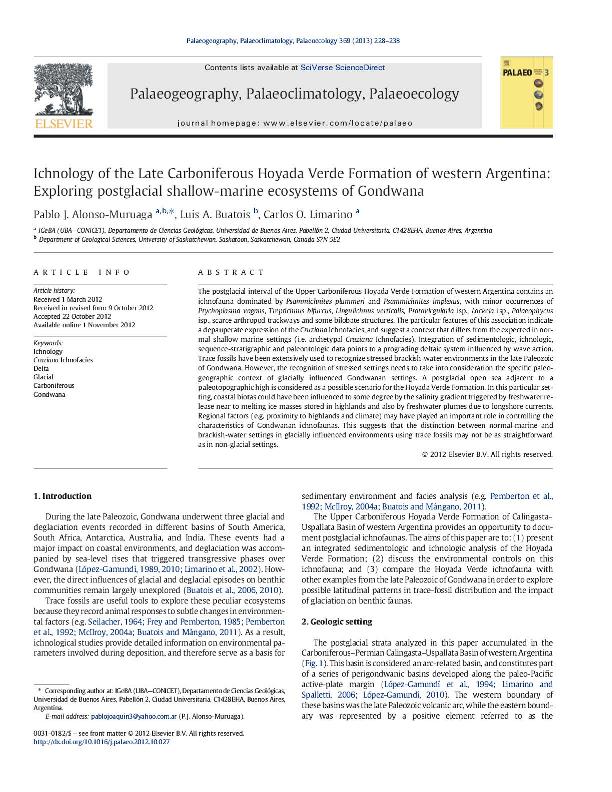Mostrar el registro sencillo del ítem
dc.contributor.author
Alonso Muruaga, Pablo Joaquin

dc.contributor.author
Buatois, Luis Alberto

dc.contributor.author
Limarino, Carlos Oscar

dc.date.available
2019-01-17T21:49:00Z
dc.date.issued
2013-01
dc.identifier.citation
Alonso Muruaga, Pablo Joaquin; Buatois, Luis Alberto; Limarino, Carlos Oscar; Ichnology of the Late Carboniferous Hoyada Verde Formation of western Argentina: Exploring postglacial shallow-marine ecosystems of Gondwana; Elsevier Science; Palaeogeography, Palaeoclimatology, Palaeoecology; 369; 1-2013; 228-238
dc.identifier.issn
0031-0182
dc.identifier.uri
http://hdl.handle.net/11336/68237
dc.description.abstract
The postglacial interval of the Upper Carboniferous Hoyada Verde Formation of western Argentina contains an ichnofauna dominated by Psammichnites plummeri and Psammichnites implexus, with minor occurrences of Ptychoplasma vagans, Treptichnus bifurcus, Lingulichnus verticalis, Protovirgularia isp., Lockeia isp., Palaeophycus isp., scarce arthropod trackways and some bilobate structures. The particular features of this association indicate a depauperate expression of the Cruziana Ichnofacies, and suggest a context that differs from the expected in normal shallow-marine settings (i.e. archetypal Cruziana Ichnofacies). Integration of sedimentologic, ichnologic, sequence-stratigraphic and paleontologic data points to a prograding deltaic system influenced by wave action. Trace fossils have been extensively used to recognize stressed brackish-water environments in the late Paleozoic of Gondwana. However, the recognition of stressed settings needs to take into consideration the specific paleogeographic context of glacially influenced Gondwanan settings. A postglacial open sea adjacent to a paleotopographic high is considered as a possible scenario for the Hoyada Verde Formation. In this particular setting, coastal biotas could have been influenced to some degree by the salinity gradient triggered by freshwater release near to melting ice masses stored in highlands and also by freshwater plumes due to longshore currents. Regional factors (e.g. proximity to highlands and climate) may have played an important role in controlling the characteristics of Gondwanan ichnofaunas. This suggests that the distinction between normal-marine and brackish-water settings in glacially influenced environments using trace fossils may not be as straightforward as in non-glacial settings.
dc.format
application/pdf
dc.language.iso
eng
dc.publisher
Elsevier Science

dc.rights
info:eu-repo/semantics/openAccess
dc.rights.uri
https://creativecommons.org/licenses/by-nc-nd/2.5/ar/
dc.subject
Carboniferous
dc.subject
Cruziana Ichnofacies
dc.subject
Delta
dc.subject
Glacial
dc.subject
Gondwana
dc.subject
Ichnology
dc.subject.classification
Paleontología

dc.subject.classification
Ciencias de la Tierra y relacionadas con el Medio Ambiente

dc.subject.classification
CIENCIAS NATURALES Y EXACTAS

dc.title
Ichnology of the Late Carboniferous Hoyada Verde Formation of western Argentina: Exploring postglacial shallow-marine ecosystems of Gondwana
dc.type
info:eu-repo/semantics/article
dc.type
info:ar-repo/semantics/artículo
dc.type
info:eu-repo/semantics/publishedVersion
dc.date.updated
2019-01-16T18:26:43Z
dc.journal.volume
369
dc.journal.pagination
228-238
dc.journal.pais
Países Bajos

dc.journal.ciudad
Amsterdam
dc.description.fil
Fil: Alonso Muruaga, Pablo Joaquin. Consejo Nacional de Investigaciones Científicas y Técnicas. Oficina de Coordinación Administrativa Ciudad Universitaria. Instituto de Geociencias Básicas, Aplicadas y Ambientales de Buenos Aires. Universidad de Buenos Aires. Facultad de Ciencias Exactas y Naturales. Instituto de Geociencias Básicas, Aplicadas y Ambientales de Buenos Aires; Argentina. University of Saskatchewan; Canadá
dc.description.fil
Fil: Buatois, Luis Alberto. University of Saskatchewan; Canadá. Consejo Nacional de Investigaciones Científicas y Técnicas; Argentina
dc.description.fil
Fil: Limarino, Carlos Oscar. Consejo Nacional de Investigaciones Científicas y Técnicas. Oficina de Coordinación Administrativa Ciudad Universitaria. Instituto de Geociencias Básicas, Aplicadas y Ambientales de Buenos Aires. Universidad de Buenos Aires. Facultad de Ciencias Exactas y Naturales. Instituto de Geociencias Básicas, Aplicadas y Ambientales de Buenos Aires; Argentina
dc.journal.title
Palaeogeography, Palaeoclimatology, Palaeoecology
dc.relation.alternativeid
info:eu-repo/semantics/altIdentifier/url/https://www.sciencedirect.com/science/article/pii/S0031018212006104
dc.relation.alternativeid
info:eu-repo/semantics/altIdentifier/doi/http://dx.doi.org/10.1016/j.palaeo.2012.10.027
Archivos asociados
